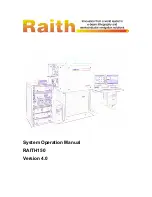
2-25
2
e.g. The ASCII value 65 sets the eight output bits to 0100 0001
BINARY characters transfer an 8-bit value to the digital I/O connector as
a single character. Value is 0 to 255. BINARY characters should be used
with care since they are not always printable and can represent a command
terminator such as the linefeed character.
2.8.3
Digital I/O Lines
The forty-eight bidirectional data lines (CH1-48) have 33 Kohm pullup
resistors and are shown numbered 1 thru 6 in ascending order In Table 2-
7. For BCD or HEX data transfer, each byte is split into two 4 bit nibbles.
Nibbles are numbered Most Significant to Least Significant Nibble in left
to right order like writing a number on paper. Data transfer order is in the
MSN to LSN direction which is the same order as the ascending byte count.
The user can leave the bytes unassigned for direct byte I/O or assign
multiple bytes into Talk (input) or Listen (output) strings. Bytes assigned
to strings must be assigned in numerical order and can start with any byte
number. User sets data polarity, conversion format and data transfer
handshaking. The recommendation is to use bytes 1 and 2 for inputs to
preserve the monitoring capability.
2.8.4
Input Handshaking
When input handshaking is enabled, the External Data Ready (EDR) signal
sets the EDR flip-flop and tells the 4863/2363 that the external data is valid
and can be read. The INH output signal is generated by the EDR flip-flop.
The data must stay steady from the leading edge of the EDR signal to the
trailing edge of the Inhibit (INH) signal. The user can select positive or
negative going EDR edge, high or low true Inhibit signal and several modes
of inputting the data. Figure 2-9 shows the relative signal timing. Absolute
timing depends upon the input mode selected.
Data
EDR Strobe
Inhibit
Figure 2-9 EDR Signal Timing
















































